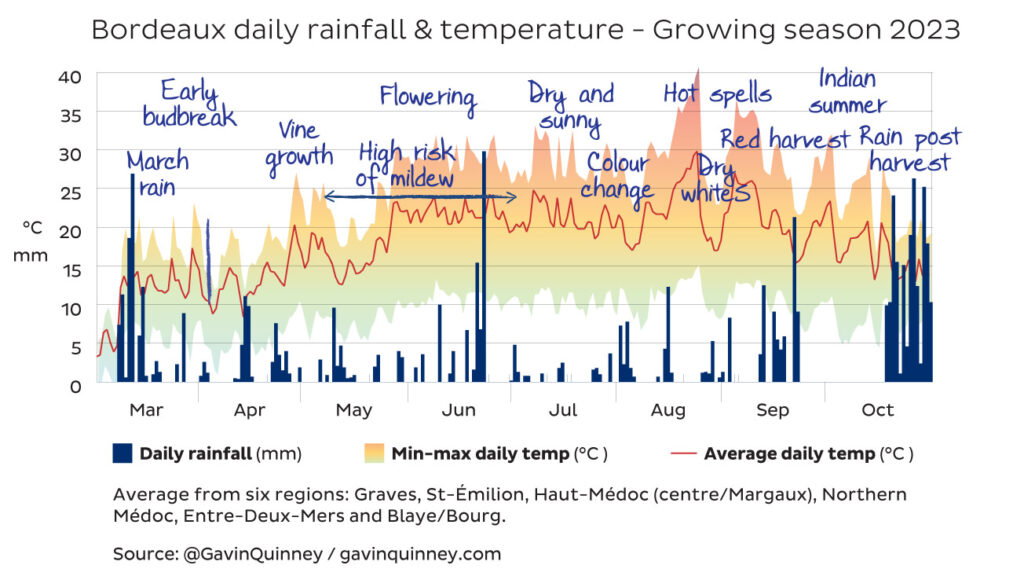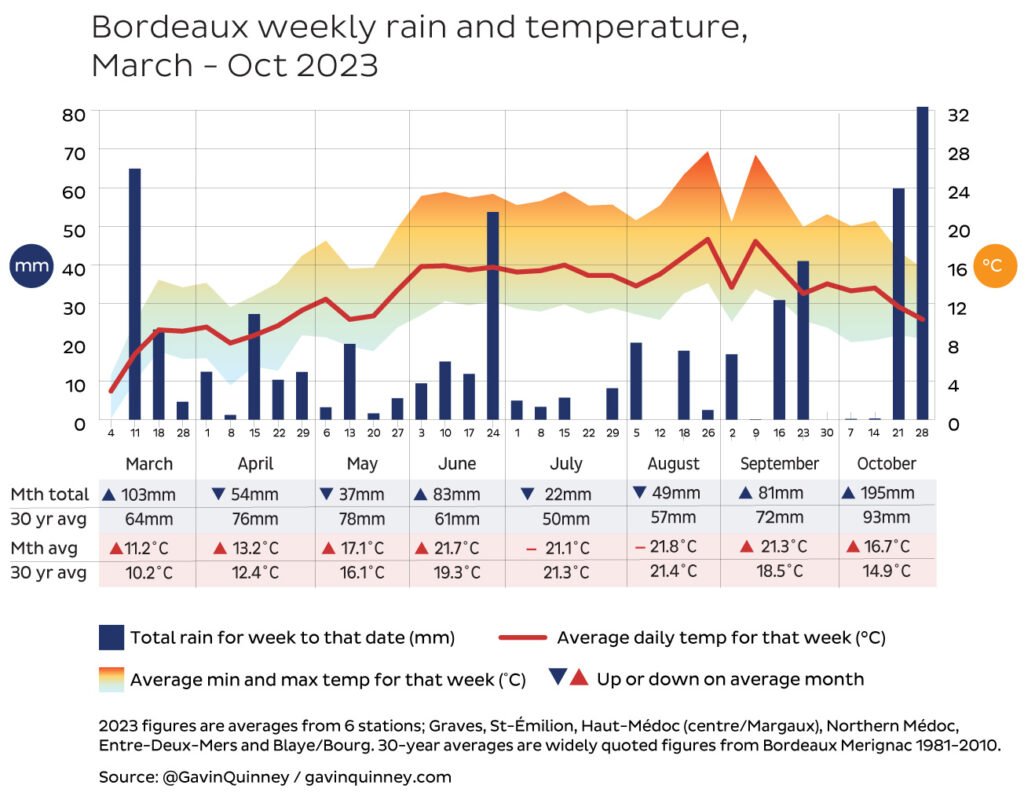Bordeaux 2023 weather and crop report
For the estates which managed to avoid mildew in 2023 “everything points to what might be called a ‘classic’ Bordeaux vintage” according to Bordeaux grower, winemaker and writer Gavin Quinney (@GavinQuinney). In the article below, he summarises everything you need to know about this year’s harvest.
Introduction
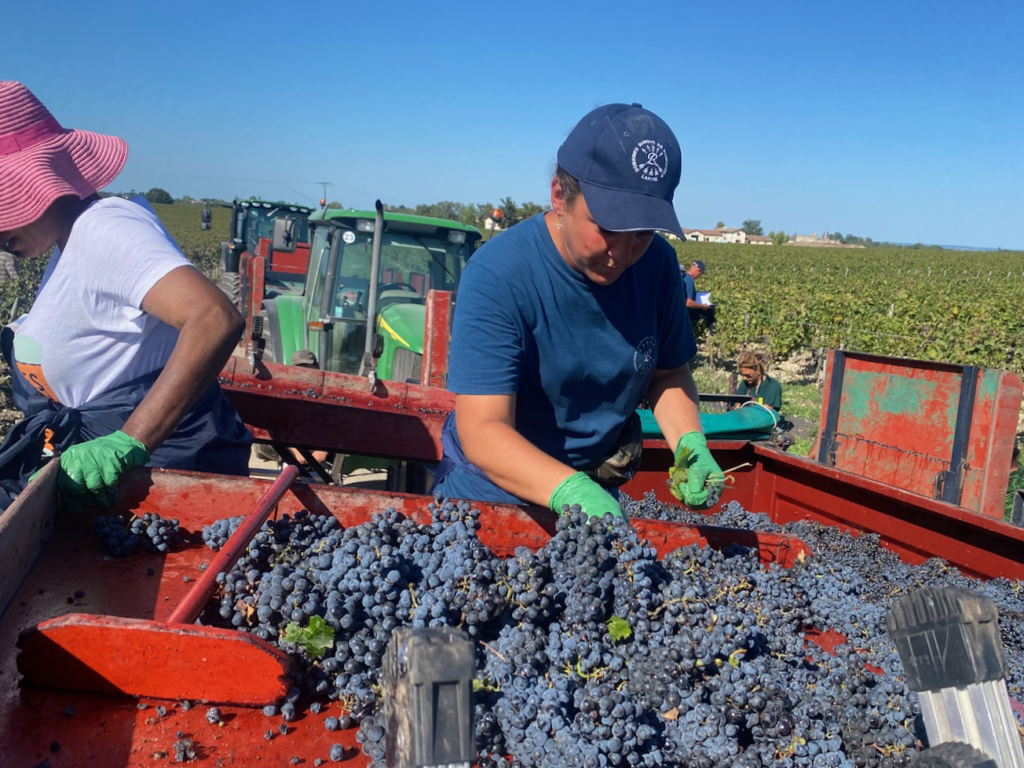
With the world of fine wine descending on Bordeaux to taste the latest vintage in the second half of April, here’s my report on how the weather in 2023 shaped the wines and the size of the crop.
It should help to serve as a backdrop as to why the wines taste the way they do – even at this early stage for the most sought-after reds – and to put 2023 into context by comparing the conditions with previous years.
The ‘en primeur’ tastings of young samples by critics, commentators and merchants are aimed primarily at the upper end of the market though it’s worth looking at the Bordeaux region as a whole when it comes to a vintage assessment.
As we shall see, 2023 is another year when the overall volume is quite low, yet the yields for the more prestigious appellations are comparatively generous.
As ever, I’ve put together a formidable series of tables, graphs and maps on both the weather and the production statistics. Some graphics are new while others updated with the new vintage.
Production overview
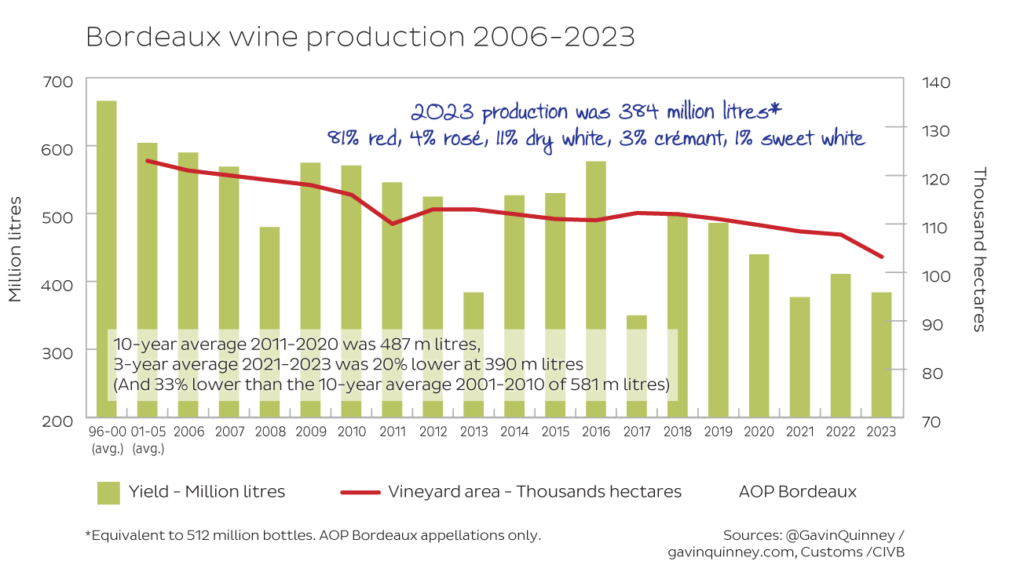
In 2023 Bordeaux produced 81% red, 4% rosé, 11% dry white, 3% crémant (most of which was white) and 1% sweet white. I’ll drill down on these under ‘Production details’ further on.
2023 was the third in a row of small Bordeaux crops overall, with 384 million litres and 37hl/ha (hectolitres per hectare). 2022 and 2021 saw 411 million litres (38hl/ha) and 377 million litres (35hl/ha) being produced respectively, beating 2017’s 350 million litres (31hl/ha).
This three-year average from 2021-2023 of 390 million litres was 20% lower than the annual average of 487 million litres of the previous decade (2011-2020). In 2001-2010 Bordeaux made half much as more wine each year on average, with 581 million litres average per annum.
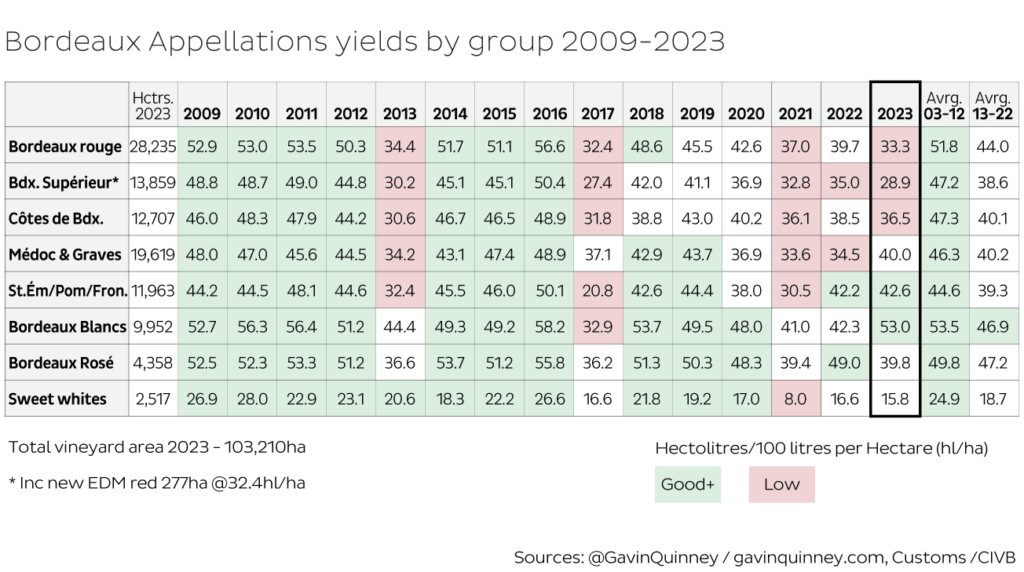
If we look at the breakdown of the Bordeaux appellations by group, it was another tough year for generic red Bordeaux and Bordeaux Supérieur – on average, yields-wise – though a good year for dry whites.
Generally speaking, the years where low yields are highlighted in pink were the most challenging. 2013 stands out as the most ‘difficult’ vintage this century, except for sweet whites. 2017 was the year of the late April frost, impacting so much of Bordeaux except those appellations alongside the Gironde estuary (see the table below). There were spring frosts too in 2021, another tricky vintage, and although 2022 saw extended drought and heat impacting yields, it’s considered by many as an excellent year for quality. As we shall see, many vineyards were hit by downy mildew in 2023 but it is a case of ‘the haves and have-nots’ across the board.
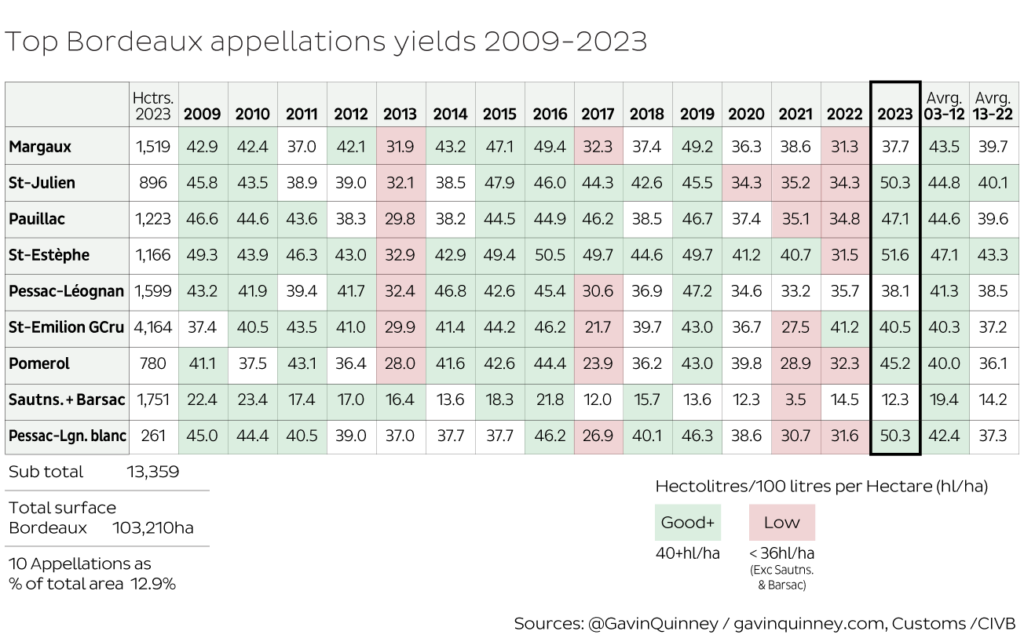
Crucially, 2023 saw pretty generous yields in the more prestigious appellations, not least compared to 2022 in Saint-Julien, Saint-Estèphe, Pauillac and Margaux on the left bank of the Gironde estuary, and in Pomerol on the right bank. It’s not for me to say but this may have an influence in the pricing strategy of certain estates during the ‘en primeur’ or ‘futures’ campaign.
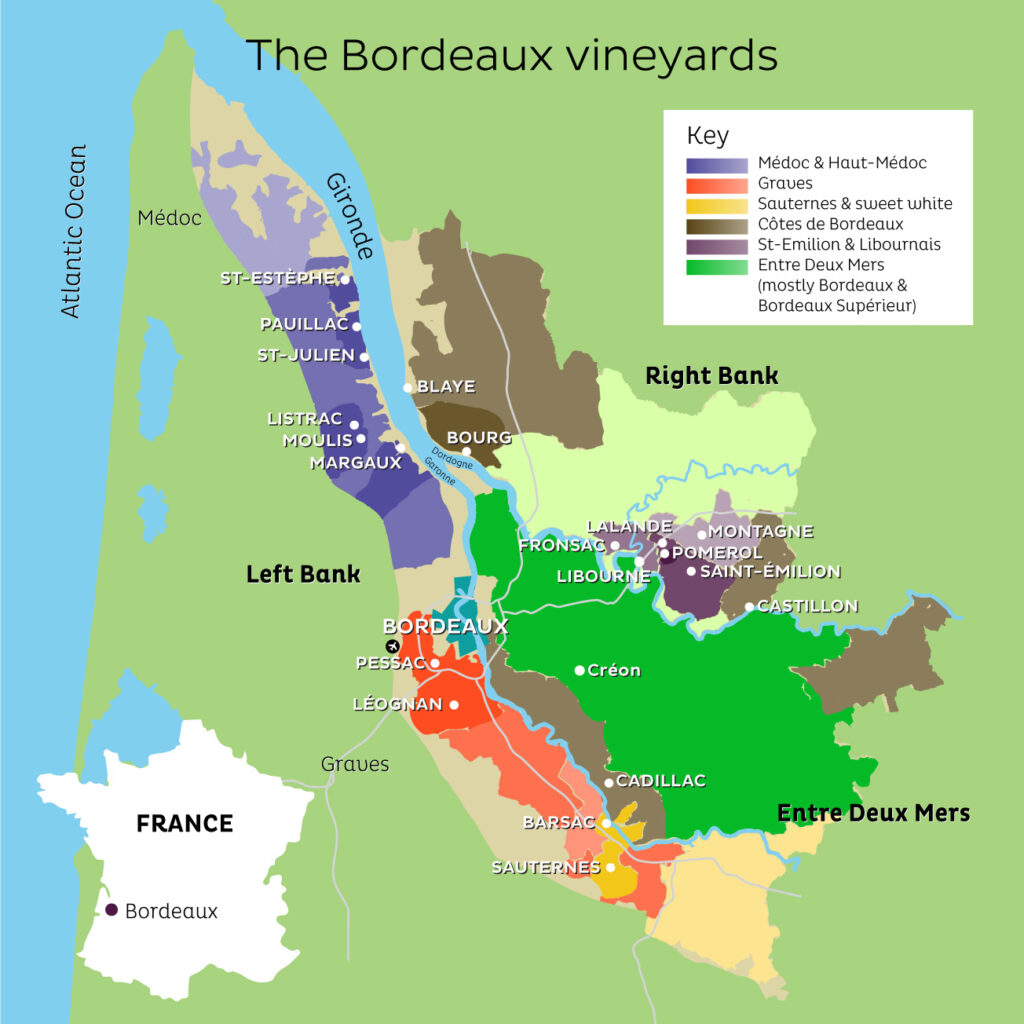
Speaking of primeurs, the vast majority of higher end wines come from these appellations, plus a few from the Haut-Médoc, the Côtes de Bordeaux, the Libournais, Graves and so on. Even at 13% of the surface area of the Bordeaux region this would considerably overstate the amount of wine involved in the en primeur campaign. The Saint-Émilion Grand Cru appellation, for example, dwarfs the others in the table above but only about a third of that appellation is home to what might be considered ‘en primeur’ level wines.
At this point, a map of the Bordeaux vineyards might prove handy to see where these places are, and what constitutes left and right bank and so forth. The Entre Deux Mers is where most of the generic red Bordeaux comes from, as we shall see further on when I focus on the production statistics.
The weather for Bordeaux 2023
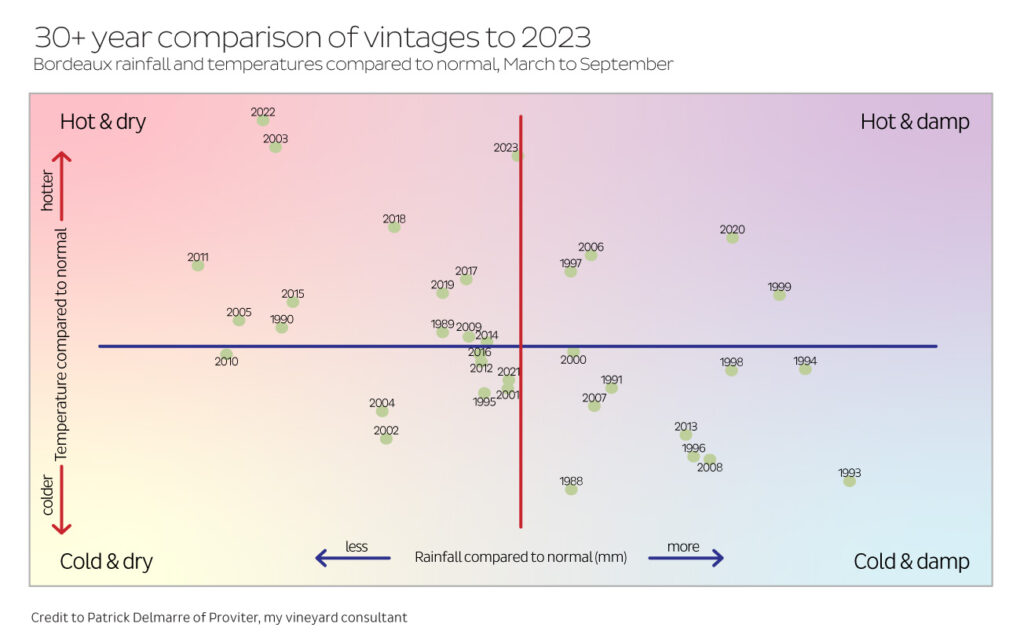
One question people often ask during the primeur tastings is ‘is this vintage similar to any previous years?’ The answer is generally no but here is a new chart showing broadly where the last 30 or so years sit in terms of the weather conditions – namely rainfall and temperature compared to the norm. The data comes from the often-quoted Bordeaux Mérignac, not from my multiple sources as in the graphs that follow.
This might appeal to Bordeaux geeks but what’s also interesting for this report is where 2023 sits. It was a very warm year overall, from March to September, with average rainfall. (As a grower of both white and red who relies on rain at the right time during the season, as we are not allowed to irrigate the vines in Bordeaux – a year like 2023 was preferable to the drought and heat of 2022 – provided you kept the mildew at bay.)
This is a chart I’ve put together each year since the 2016 vintage, taking the data from six sub-regions of Bordeaux to get a more representative picture of the vintage. Note that there can be significant variations in rainfall from one area of Bordeaux to another at key times.
You can see how the different vintages compare at the foot of this article in the appendix.
I’ve included March and October for 2023, bookended onto the key six months of the actual growing season from April to September. Budbreak was early, in late March, and the ‘high risk of mildew’ in the following quarter was by far the most pronounced I’ve seen in the 25 years that I’ve lived here.
After storms in late June we had a good summer, and most of the red grapes (over 80% of Bordeaux production is red) were harvested in September. The rain in the second half of October had minimal impact on the vintage as the crop was in, but it’s useful for answering the question about what the weather is like in October. ‘Can be absolutely glorious, but sometimes …’
This is a similar chart, but taking the weekly rain totals and average temperatures from the six stations. I’ve then compared the monthly statistics to the often quoted 30-year average to show how 2023 compares to the norm. Every month was warmer in 2023, except July and August which were broadly in line with the average.
As mentioned above, the October figure is largely irrelevant for the wines of 2023.
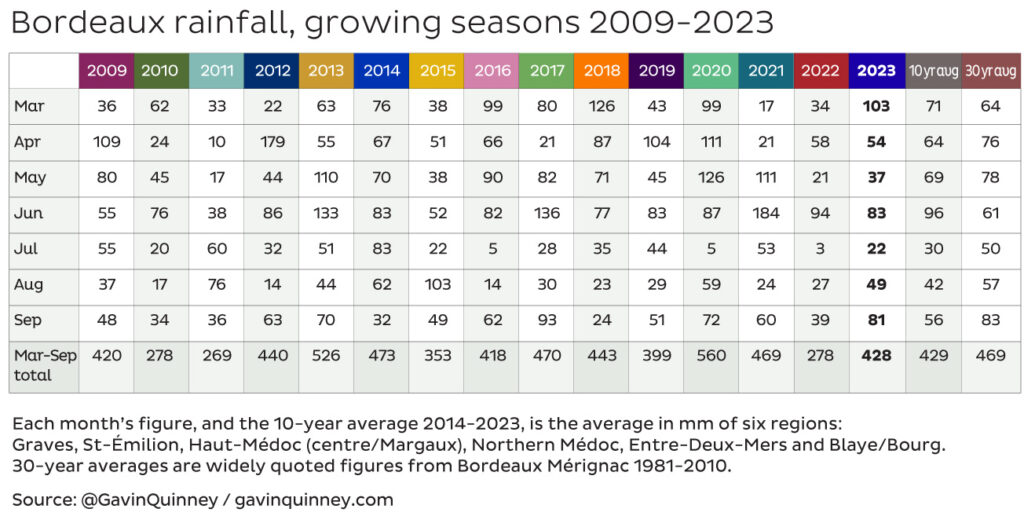
Here’s a table showing how the rainfall in 2023 compares to previous years back to 2009, and against the average. I’ve kept 2009 and 2010 in there as they’re both great Bordeaux vintages. The total from March to September was bang on the 10-year average of the same weather stations, in contrast to the very dry 2022.
July is consistently dry while rainfall in June is often quite high, sometimes at a crucial point in the growing season. You can see in the charts in the appendix that heavy rain in June can often come in just a few days, as in 2023
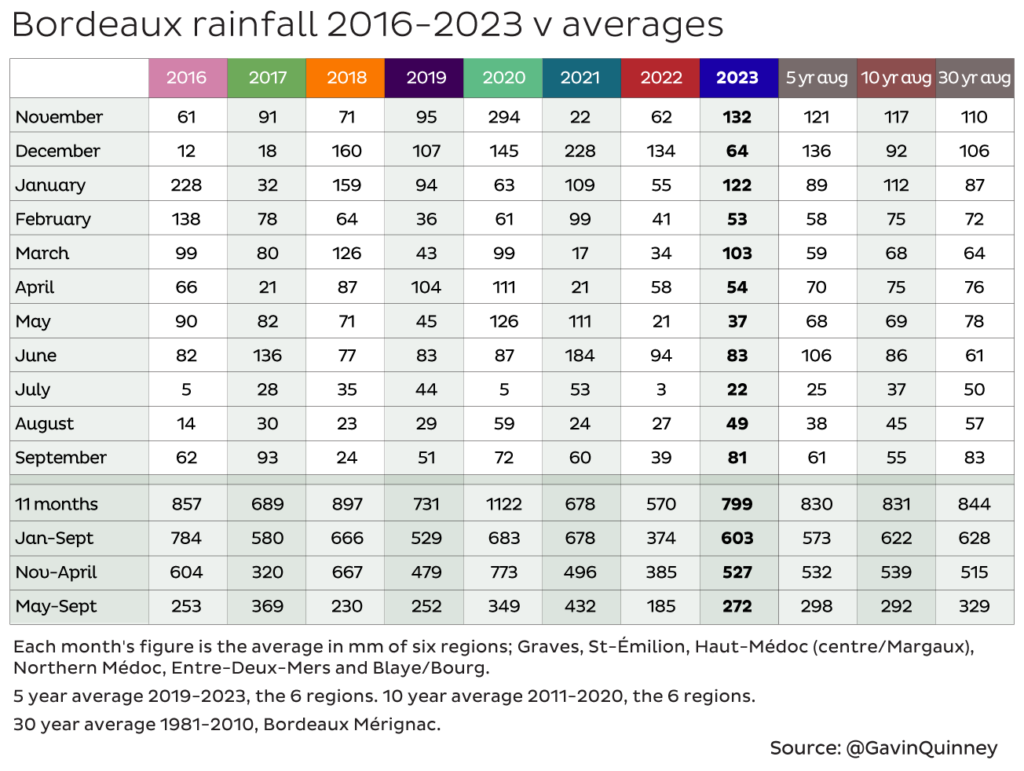
Forgive me for this additional table on rainfall but the winter is important too and it’s useful to see how things are evolving over 5 and 10 year spreads. 2023 is very much in line with the 5 and 10-year averages.
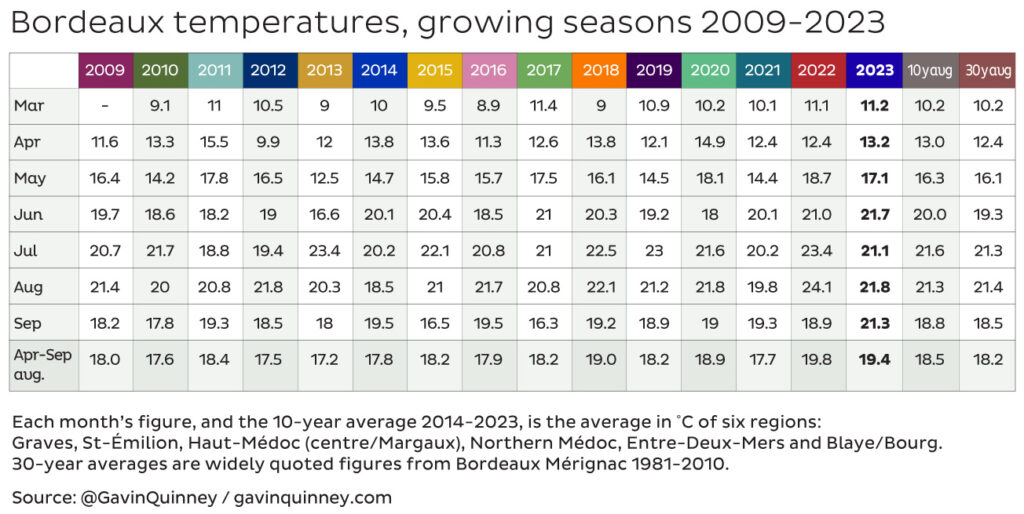
2023 was a warm year. I’ve taken the average from April to September as that’s the growing season proper. The figures for the individual months are quite different though to 2022 and 2021 – not least July and August.
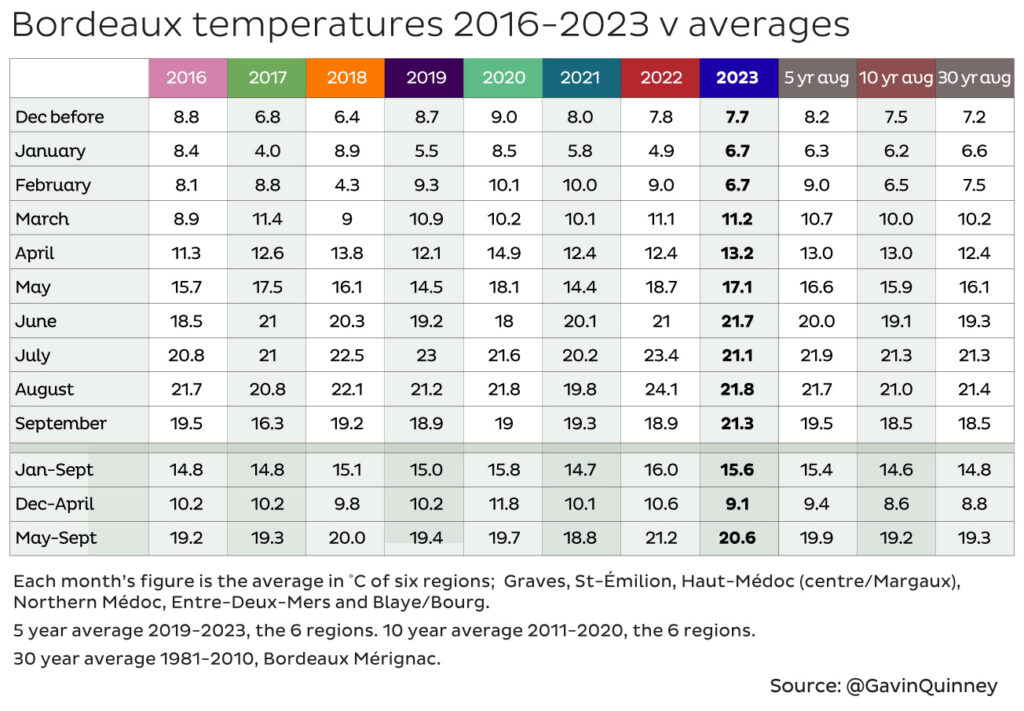
Here’s the broader range of average temperatures, including the winter months. Again, May to September was warm in 2023 as an average.
The threat of mildew
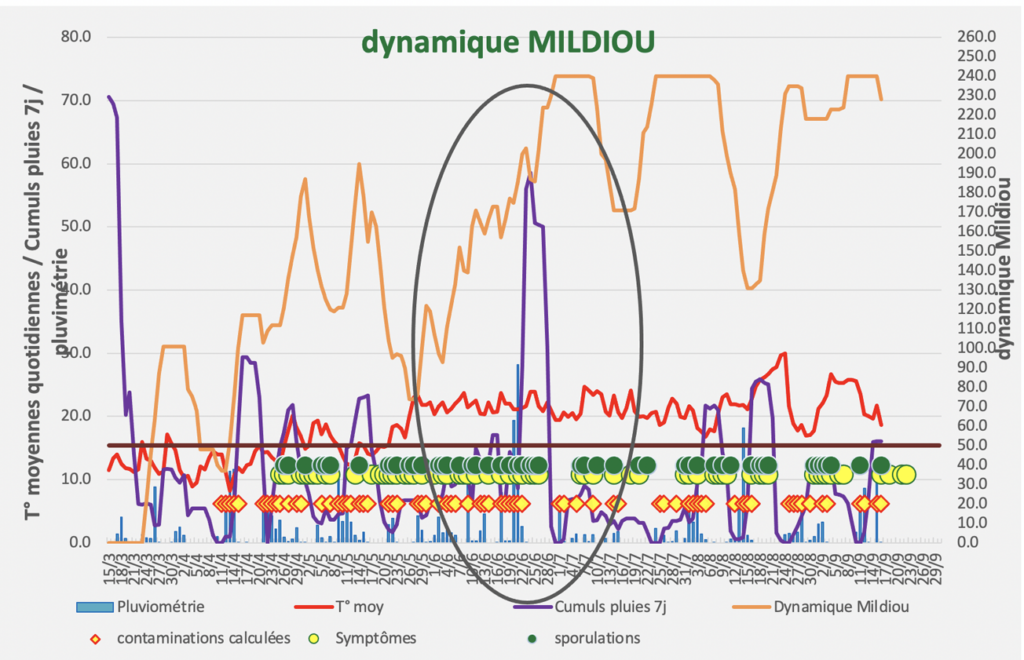
Hail and a spring frost are probably the two things we fear the most, but the threat of mildew is when we have to be at our most vigilant, and ready to treat the vines at short notice.
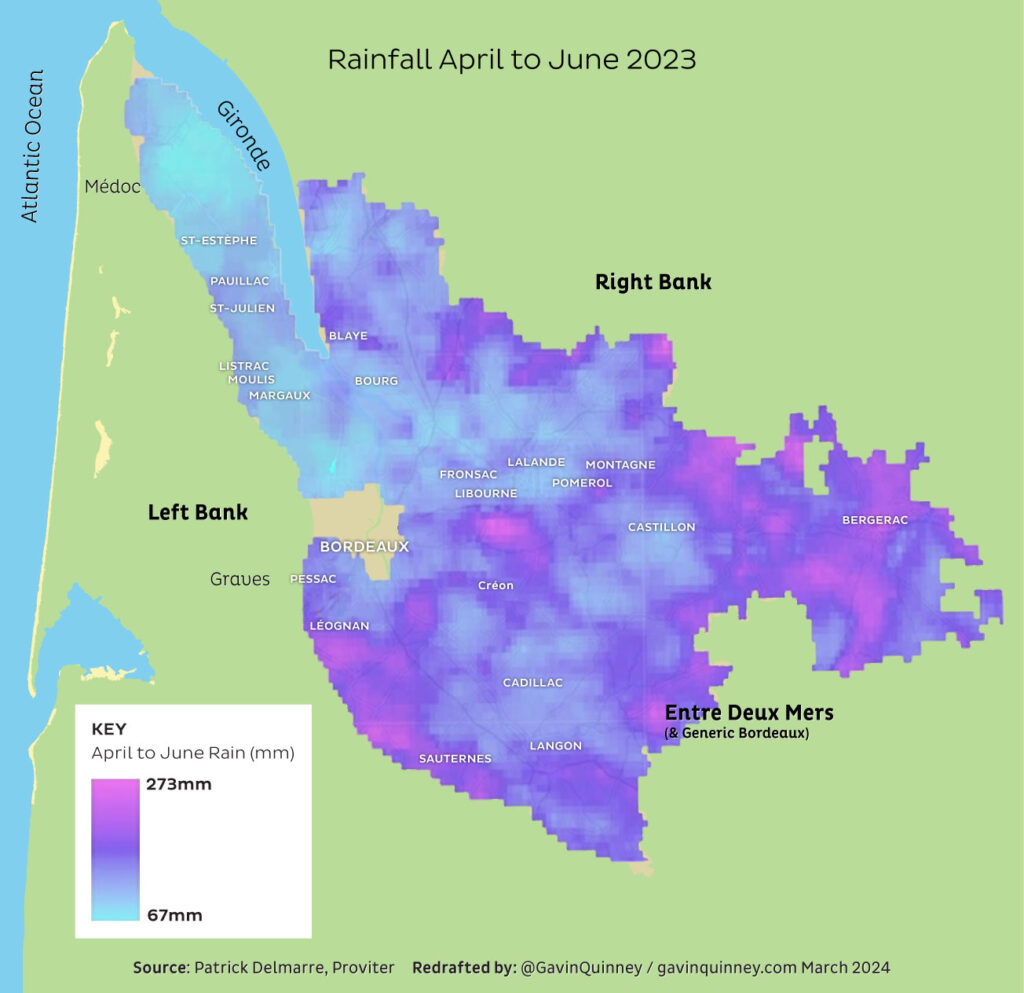
Three of the last six vintages have seen a high risk of mildew (and the year before those, in 2017, we had frost). Broadly speaking 2018 – a very good vintage notwithstanding – saw mildew in the early part of the growing season, 2021 had late season mildew, and now 2023 topped the lot with both early and late.
2023 has seen the worst impact on the Bordeaux vineyard but mildew has impacted some vineyards and not others – depending on the immediate climate, rainfall and timing and efficiency of the spray treatments. Some of the least affected were the drier zones.
The day before the French national holiday on 14 July, the Sud-Ouest didn’t mince their words. ‘Mildiou’ in French refers to downy mildew and ‘oidium’ to powdery mildew, by the way.
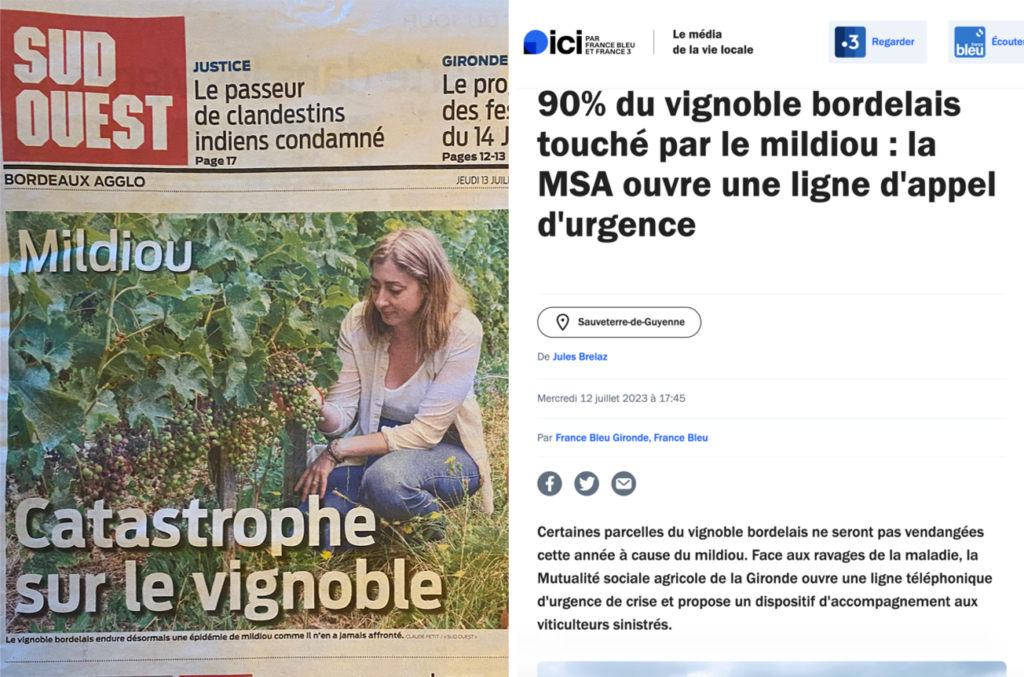
‘90% of Bordeaux vineyards touched by mildew’ was widely reported and help lines were set up.
‘Unstoppable’ in the Sud-Ouest and, in the Gironde, ‘we sleep on the tractors, it’s a battle’.
The impact on the bunches, let alone the leaves, was clear when you looked under the canopy. This was a neighbour’s vineyard versus our own at the end of July during veraison (colour change).
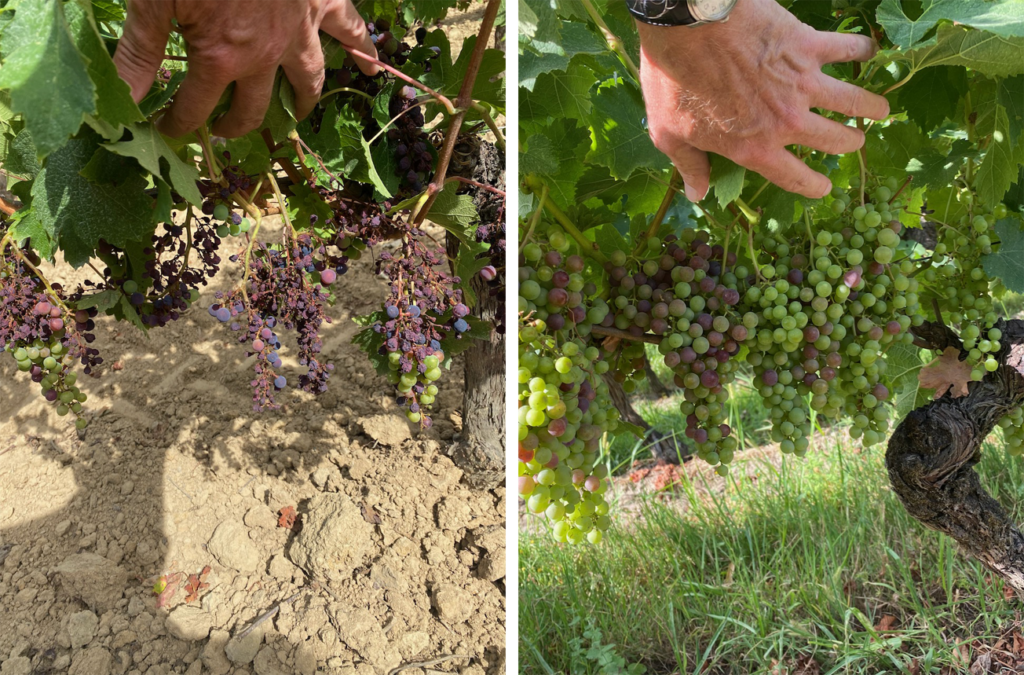
The story somehow escalated as ‘90% of the Bordeaux crop destroyed‘ on page three in The Daily Telegraph. More than a few people sent a note to check if we were still in business.
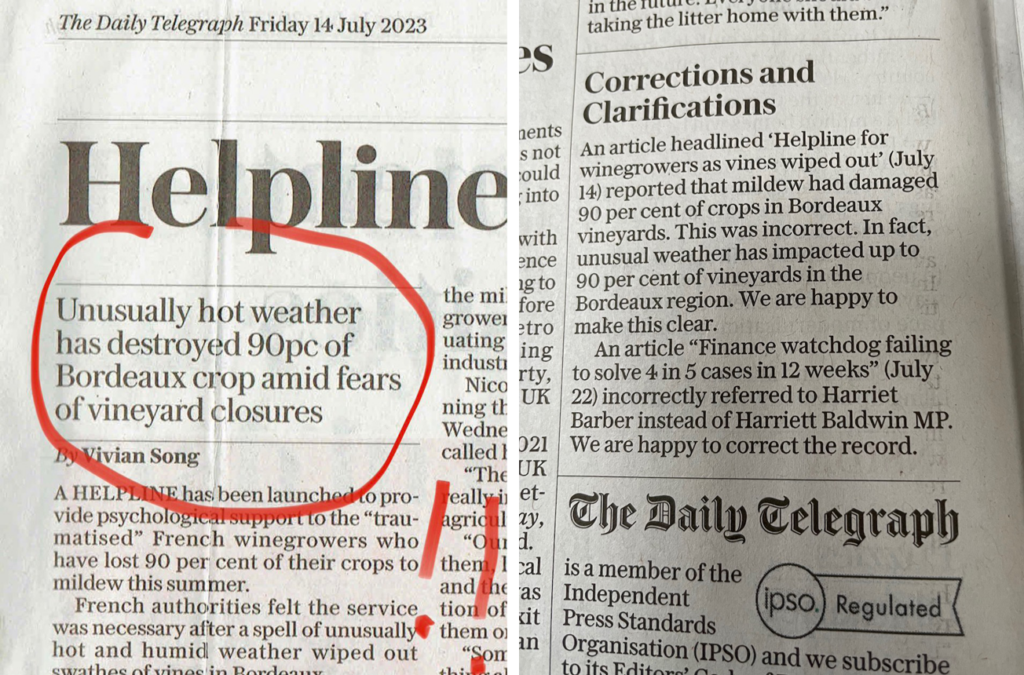
After getting in touch with the journalist in Paris, I wrote in at her suggestion. The subheading for this article states ‘Unusually hot weather has destroyed 90pc of Bordeaux crop’. This is a misinterpretation of French media reports stating that 90pc of Bordeaux vineyards have been ‘touched’ or impacted by mildew, to a lesser or greater extent. We too have seen some mildew on our 30-hectare vineyard – it is indeed a serious issue – but we’ve lost perhaps 1 per cent of the crop, if that. Others similarly. We’ve worked really hard to keep the mildew and other vine diseases at bay. So the correction should read ‘We stated …xx but it should have read ‘unusual weather has impacted up to 90pc of the Bordeaux vineyards’.
‘The proof will be in the harvest figures when they are released, when the Bordeaux crop size will be far, far closer to, say, the average of the last three years’ crop than to just 10% of that figure.’
The Telegraph duly printed a correction and clarification on page two a few days later.
A fine crop elsewhere
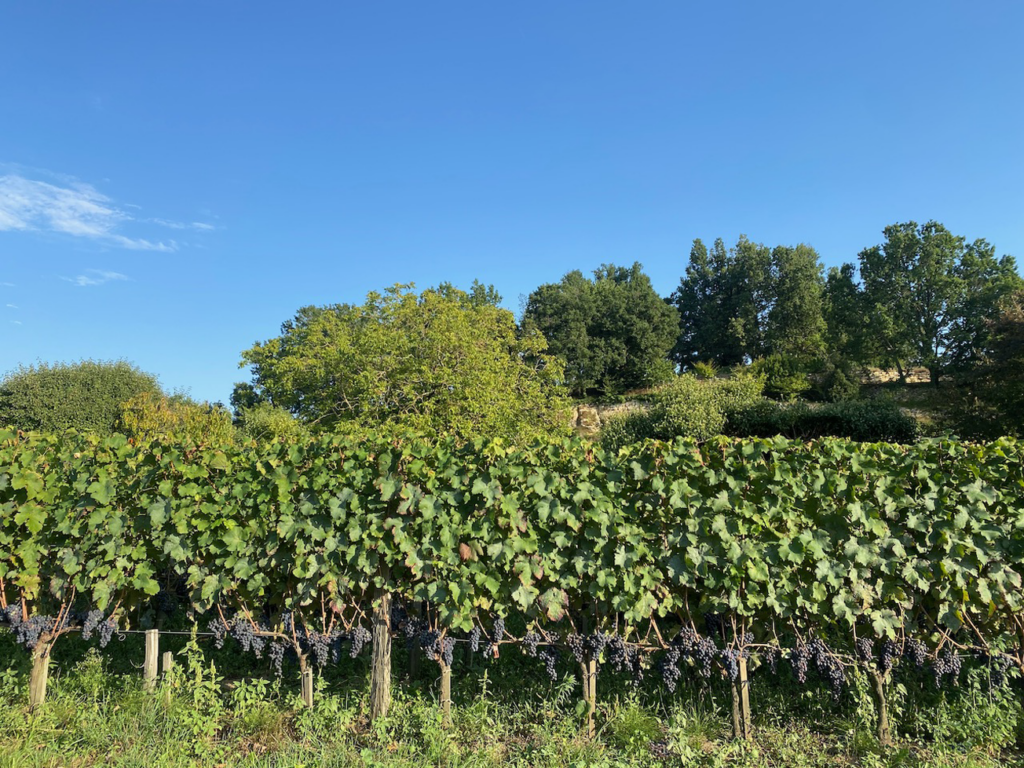
Many estates managed to avoid mildew – or were hardly impacted at all due to their location – and had a healthy and generous crop. This was Merlot in Saint-Émilion at the end of August.
It’s an important point. While it was devastating for some, there were plenty of bunches elsewhere.
So what should we expect from the vineyards which avoided mildew? Well, everything points to what might be called a ‘classic’ Bordeaux vintage, one where the better wines show fruit and finesse over structure, richness and power. A year for fraîcheur (freshness) and équilibre (balance), brought about by terroir, gentle extraction, slightly lower alcohol and bright acidity. And the like.
There’s little doubt that 2016, 2018, 2019 and 2020 were terrific years for red Bordeaux and 2022 was widely appreciated by most observers when tasted from barrel. I’d be surprised if 2023 is put in the same bracket as those vintages but it should be ranked somewhere between those and 2017 and 2021, depending on the appellation and the estate.
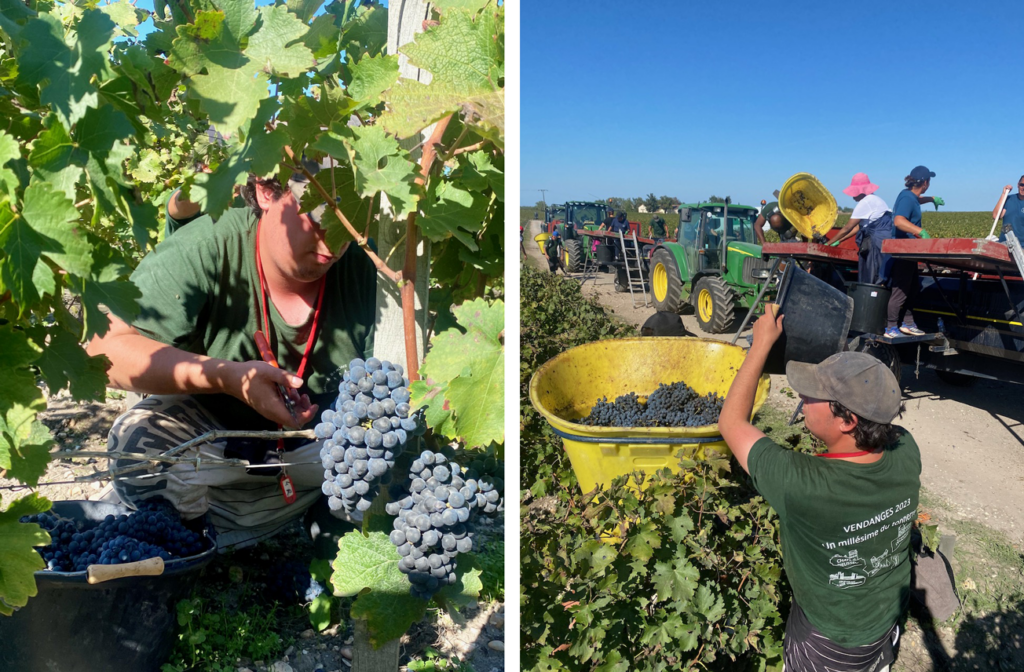
The Cabernet Sauvignon harvest at Château Lafite in Pauillac, late September 2023.
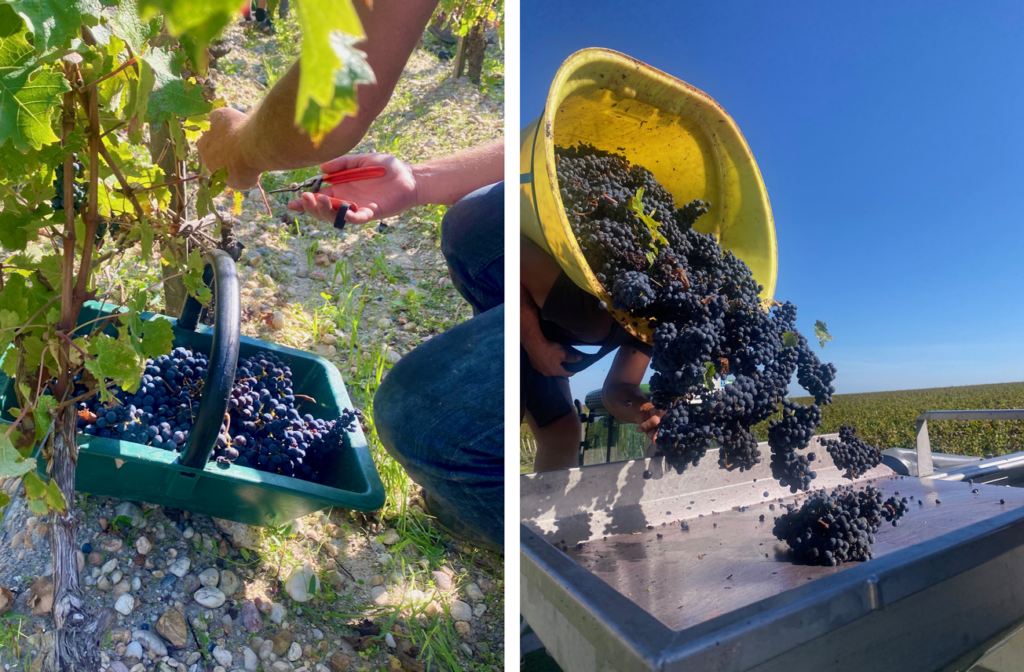
Château Calon Ségur in Saint-Éstephe, late September 2023.
For full production details and the appendix, visit www.gavinquinney.com.
Fill in the form below to subscribe to real-time release alerts during the En Primeur campaign.

